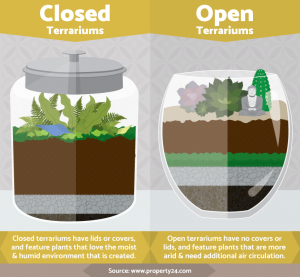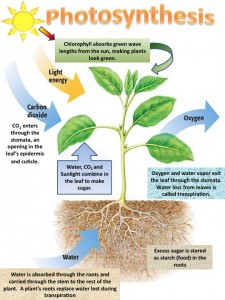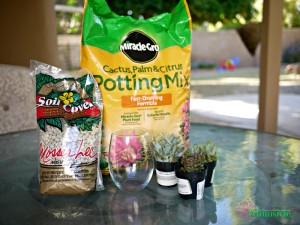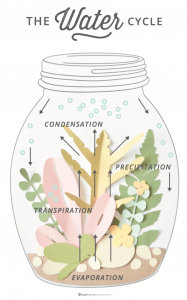Kenton County Public Library recently held a program called Tiny Terrariums at the Erlanger Branch, and it was very well-attended! Students ages 8-16 were invited to attend, and the program filled at 40 attendees. Many of the students were accompanied by interested adults as well.
 We began the program with a presentation of some basics regarding terrariums. Scientific vocabulary was included to make the program a little more than just a “how-to.” We discussed the differences between closed and open terrariums, kinds of soil, plants, and conditions they require, how the water cycle works in a closed terrarium, and more. The four main processes in the water cycle were defined and related to a steamy bathroom following a shower, which made the concepts a little simpler for the youngest students. Proper scientific definitions were included in all the discussions.
We began the program with a presentation of some basics regarding terrariums. Scientific vocabulary was included to make the program a little more than just a “how-to.” We discussed the differences between closed and open terrariums, kinds of soil, plants, and conditions they require, how the water cycle works in a closed terrarium, and more. The four main processes in the water cycle were defined and related to a steamy bathroom following a shower, which made the concepts a little simpler for the youngest students. Proper scientific definitions were included in all the discussions.
How the water cycle works in a closed terrarium was contrasted with the slightly different ecosystem found in an open terrarium, and the concept of microcosm was defined and discussed as well. We talked about what kinds of plants one normally finds in the desert, versus the rain forest, and how that would translate into the microcosm of a terrarium. Additionally, the topic of  photosynthesis was addressed. This lead in to the discussion about the necessary conditions to keep their completed terrariums healthy, including how much sun is needed, how much and when to water, and temperature requirements. Lastly, an article was shared about a man who created a closed terrarium in 1960, and hasn’t had to water it since!
photosynthesis was addressed. This lead in to the discussion about the necessary conditions to keep their completed terrariums healthy, including how much sun is needed, how much and when to water, and temperature requirements. Lastly, an article was shared about a man who created a closed terrarium in 1960, and hasn’t had to water it since!
 Once the scientific intro was completed, it was time for creating! A few basic supplies, all easily obtained, were all that we needed. Gravel for drainage, sand, potting soil, decorative rocks and marbles, and small succulents completed our terrariums. For our program, the plants were ordered from an online succulents supplier, and the potting materials all came from the local Home Depot. Glass containers of varying shapes were obtained inexpensively at the dollar store.
Once the scientific intro was completed, it was time for creating! A few basic supplies, all easily obtained, were all that we needed. Gravel for drainage, sand, potting soil, decorative rocks and marbles, and small succulents completed our terrariums. For our program, the plants were ordered from an online succulents supplier, and the potting materials all came from the local Home Depot. Glass containers of varying shapes were obtained inexpensively at the dollar store.
One of the adult patrons who attended the program with her daughters leads a home school co-op locally. Following the program, I was asked if I could do the same presentation for the home school group, at a future program in which they would create their own terrariums. This gives me a great opportunity for an outreach program, and helps to solidify the link between the library and the co-op as well, giving us more bang for the buck! As a Children’s programmer, I partnered with the Teen Librarian on this program, and we managed to reach a slice of the patron population that sometimes gets overlooked. Not only did we have the interest of the tweens, we served some home school families and created the opportunity to serve more. And since the materials for this program are a little more costly, the expense could be shared by the Teen and Children’s departments, meaning we could allow a larger audience. Capping the registration would be an easy way to hold down costs. Costs could also be minimized further if participants were asked to bring their own containers for their terrariums.
All told, the 40 participants had a great time. They learned some scientific terms, got to complete a hands-on project, AND took home a tiny garden to look after!





That sounds like a great program!! Maybe I can get our teen reps interested in doing it with me for spring break next year, when teens are having to hang out with younger siblings because school is out…. You have fantastic ideas, Jennifer!
Thanks, Luna! I have to admit that this one wasn’t my idea… I partnered with our YA person on this, and it was really her program. It was a great idea, and it was a lot of fun! 🙂